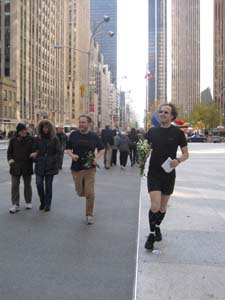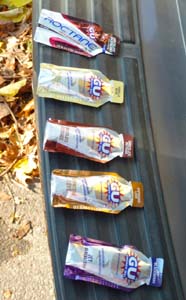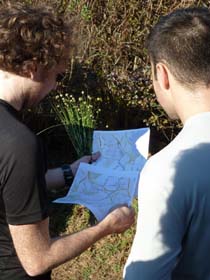Exhibition Reviews
| Home | | Museum Guide | | International | | Theater |
Why not perform with a run of 33 miles?
By Eva Ostrowska, November 2011
Guido Van der Werve "Second Annual Run to Rachmaninov
- Effugio no 2 Running to Rachmaninov"
From Luhring Augustine Gallery, 531 W 24th St New York,to Valhalla, NY.
Saturday November 12, 2011
http://www.luhringaugustine.com
 |
| Guido Van der Werve and Ragnar Kjartansson running in New York City. Photo courtesy of the gallery. |
If you are tired of superficial, quick and easy exhibitions which seem
to be oriented to market desires, the work of Guido van der Werve should
come as
something of an antidote. A week after the N.Y.C Marathon, Dutch video artist
Guido van der Werve comes with a mission: carrying a bouquet of
chamomile flowers on a run of 33 miles from the Luhring Augustine Gallery
in Chelsea to composer Sergei Rachmaninov’s gravesite in Valhalla,
New York. It was obvioulsy not a case of one artist running privately for
over thirty miles, but truly the work of what French critic Nicolas Bourriaud
could have called an "intersubjective exchange" as the "substrate"
for his work.
To join the Second Annual Run to Rachmaninov, called "Effugio no 2 Running to Rachmaninov" is to engage the work of Guido van der Werve that have figured prominently in contemporary discussions of an enduring artist. Werve's has a career-long interest in the harsher aspects of running and art. Depending on what you look at, his work is alternately romantic, sensitive, silent, poignant and poetic. It's always a competitive or performative aspect that draws him in.
 |
| Energy gels distributed to the runners. Photo by Eva Ostrowska. |
For some, Werve's is known mainly for "Nummer acht, Everything is going to be alright'' his 2007 movie of his amazing walk in front of an icebreaker.Others may be aware of Werve's unusual and very brave performance pieces, such as "Nummer negen, The day I didn't turn with the world," his movie of his twenty-four hours at the North Pole, walking slowly to feel the earth's rotation. He continually pushes his works to the usually tight limits of what is physically capable .
But for his "Effugio no 2 Running to Rachmaninov" as a part of Performa Festival, Werve has invited people to join him. Ten o'clock was the meeting time at the Luhrstine Augustine Gallery in Chelsea. I met Werve and the others runners including video artist Erkka Nissinen, Russian artist Anton Ginzburg who recently exhibited at the Venice Biennale; the winner of Performa’s Malcolm McLaren Awards Icelandic artist Ragnar Kjartansson, multidisciplinary American artist Eleanna Anagnos, ARTINFO's Reid Singer, the New York Observer's Andrew Russeth, and Luhring Augustine Gallery director Kristen Becker. Some of them came for the beauty of the gesture while the others came to pay tribute to the composer.
 |
| Guido Van der Werve and Reid Singer reading the map to Rachmaninov's gravesite. Photo by Eva Ostrowska. |
We all started to run with a big smiles on our faces. On a recent nothing-special
saturday morning, people in the street looked at this uncanny scene. Some
of them might have
thought it was an observance of Veteran's Day while others thought were running
for the struggle cancer.Throughout the race, we lost some of the initial runners,
some stopped before 50th street, Kjartansson and I stopped at the end of Central
Park. But Guido van der Werve, Reid Singer and Andrew Russeth kept running
all the way. Twenty miles later, Russeth was obliged to stop, but Werve and
Singer bravely made the whole run to Rachmaninov’s gravesite in Valhalla.
They both placed their flowers, and Reid switched on his mp3 player to listen
to "The Piano Concerto No.3" composed in 1909 by the Rachmaninov.
Purely as a living experience, the performance was an exquisite moment. It was extremely refreshing to discover that artists such as Guido van der Werve are not necessarily concerned with the production of images and objects. This piece had an universal quality which made it approachable and very enjoyable, on many different levels, as a purely physical performance of a romantical action. Werve reminds us that Art is not only a brush, canvas and paint, but that every movement of life is art.
.